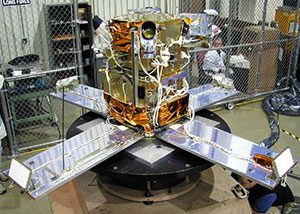High Energy Transient Explorer 2
High Energy Transient Explorer 2

The HETE-2 spacecraft during tests of it's mass properties. (Credit: NASA)
Lifetime: October 2000 - March 2007 (operational efficiency degraded)
Country (primary): United States
Primary Science
The High Energy Transient Explorer 2, or HETE-2, is designed to detect cosmic gamma-ray bursts and help determine their origin and nature.
Science Highlights
- Discovered gamma-ray burst GRB 030329, which firmly connected gamma-ray bursts with supernovas
- Discovered the short gamma-ray burst FRB 050709, which was the first short gamma-ray burst found with an optical counterpart
- Established a subclass of gamma-ray bursts, the less energetic X-Ray Flashes
- Sent first arcminute positions of gamma-ray bursts to the observation community within tens of secons of the onset of a burst.

